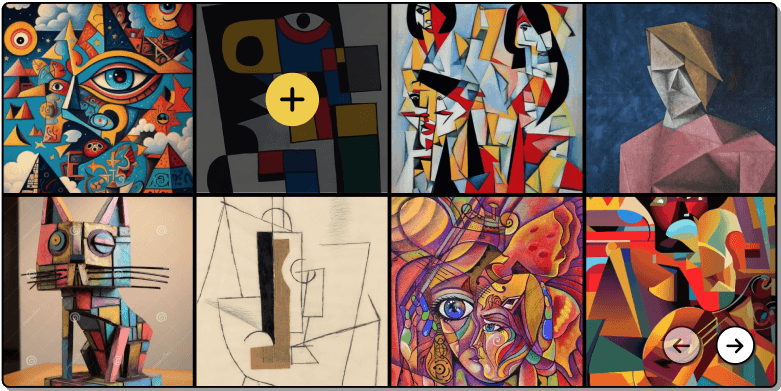Jumpstart your research with an info breakdown.
Turn complex topics into bite-sized content with Albus blocks.
No credit card required.
How Picasso inspired art world?


Artistic Techniques Innovation
His career was a tapestry of constant evolution, marked by periods of dramatic stylistic changes that influenced not just his contemporaries but generations of artists to come. Analytical and Synthetic Cubism: Picasso's foray into Cubism, as mentioned, changed the way artists perceived and depicted space and volume on the canvas. In Analytical Cubism, he deconstructed natural forms into basic geometric shapes, fracturing the picture plane and reassembling it in an abstracted form. In Synthetic Cubism, he introduced mixed media with collage techniques, expanding the definition of painting and sculpture. Blue and Rose Periods: Preceding Cubism were Picasso's Blue and Rose periods, during which he used color to convey emotion. The Blue Period, characterized by monochromatic shades of blue and blue-green, captured the themes of poverty, loneliness, and despair. The Rose Period, with its warmer orange and pink tones, represented a more optimistic phase, depicting circus performers and clowns. Primitivism: Picasso's interest in African, Iberian, and Oceanic art led to his Primitivism phase, where he incorporated elements from these traditions into his work. This is most famously observed in "Les Demoiselles d'Avignon," which is considered a precursor to Cubism and a radical departure from traditional European painting. The mask-like faces and distorted bodies opened new avenues for exploring the human form.
Cubism revolution
Pioneered by Pablo Picasso and Georges Braque, marked one of the most groundbreaking shifts in the history of art. This movement fragmented the continuity of form, challenged the conventions of perspective, and upended centuries-old techniques that sought to replicate nature. Cubism unfolded in two distinct phases: Analytic Cubism and Synthetic Cubism. Analytic Cubism was the deconstruction phase, where objects and figures were broken down into geometric shapes and represented from multiple viewpoints simultaneously. This approach dissected the subject into a series of flat planes, presenting a more abstract form of reality where time and space intertwined. The idea was not to replicate the world as it was seen, but rather as it was known, with all its complexities and contradictions. In Synthetic Cubism, which followed, artists began to introduce textures, patterns, and even foreign materials into their compositions, giving rise to the first truly mixed-media works. This was more than a stylistic evolution; it was a conceptual leap. By incorporating newspaper clippings, pieces of fabric, or wood veneer, Cubists blurred the line between art and life. The canvas was no longer just a picture plane but a real space that interacted with the material world.
How Picasso inspired art world?
+
Cubism Revolution
+
Abstract Art Advancements
+
Picasso's Blue Period
+
Expression Through Portraits
+
Political Commentary in Art
+
Experimental Use of Materials
+
Artistic Techniques Innovation
Art Pioneer
Picasso, alongside colleague Georges Braque, co-founded the Cubism art movement around 1909. Cubism showcased a dramatic shift in perspective, representing objects from multiple view points in a fractured, abstract manner.This unprecedented technique transformed the traditional, single perspective view and opened up new possibilities for visual representation. Picasso's masterpiece, "Les Demoiselles d'Avignon," is often considered the piece that ignited the Cubism movement.The painting features distorted and deconstructed figures, presented in a way that lets you view them from different angles simultaneously. Cubism not only had a profound impact on the direction of visual art, it also influenced literature and music. Picasso's innovative ideas on form and perspective changed the very definitions of artistic style, thus inspiring generations of artists.

Expand ideas in context.
Get a panoramic view with follow-up topics.

Unraveling subjects effortlessly is the key.
Albus cascades, offering follow-up topics for each subtopic's context.
This unique feature grants you a broader perspective, helping you see the subject's place within a larger framework. Albus empowers you to gain a more profound insight into your chosen area of study with its context-aware canvas engine.
Possibility of an interstellar journey?


Tell me more...
Relativity and time
Energy requirements and generation
Lack of planetary resources
Astronomical distances
Interstellar journeys face the immense challenge of astronomical distances. For instance, the closest star system to Earth, Alpha Centauri, is located approximately 4.3 light-years away. To put that into perspective, it takes light- the fastest thing we know- over four years to reach our nearest neighboring star. This vast cosmic expanse presents significant practical challenges in terms of travel time and energy required for interstellar expeditions. Even with advanced propulsion technologies, such as ion propulsion or antimatter drives, it would still take an unprecedented duration to reach another star system.
Relativity and time
Relativity and time play a crucial role in the context of interstellar journeys. According to Einstein's theory of relativity, space and time are intertwined, and their properties vary depending on the motion of an observer. When traveling near the speed of light, the concepts of time dilation and relativistic speed become significant. At high relative velocities, time dilation occurs, suggesting that time moves slower for a moving object relative to a stationary one. Consequently, an astronaut traveling at relativistic speeds could experience time passing more slowly than those on Earth. This relativistic time dilation can create significant disparities in age between travelers and those left behind. In addition to time dilation from speedy travels, the sheer distances in space also have an impact. The light-year, which represents the distance light travels in one year, imposes constraints on interstellar travel. As a journey towards distant stars progresses, relativistic speeds might need to be attained to maintain a tolerable-timespan expedition.
Possibility of an interstellar journey?
+
Astronomical distances
+
Extraterrestrial life search
+
Spacecraft propulsion methods
+
Technological challenges
+
Space travel risks
+
Black hole concerns
+
Theoretical breakthroughs

Albus is designed with one simple aim:
to provide you with a head start on your research.
Just enter the topic you want to explore and watch Albus break it into a curated list of subtopics: no frills, no overpromising – just straightforward help to guide you in the right direction.
The first step is always the hardest one. So save valuable time, avoid information overload, and focus on what truly matters – expanding your understanding. Whether you're a dedicated learner, a diligent researcher, or simply someone hungry for knowledge, Albus is your companion in making sense of information.
No credit card required.


